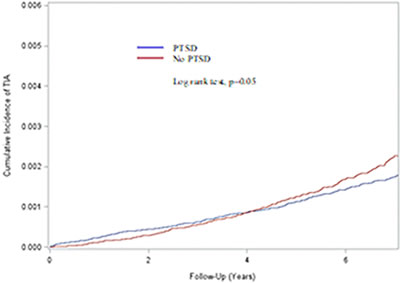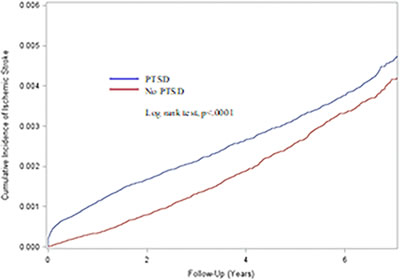
Lindsey Rosman, PhD
More Significant Risk Factor than Diabetes, Sleep Apnea
CHAPEL HILL, NC—Developing posttraumatic stress disorder as a young adult doubles a veteran’s risk of a transient ischemic attack before middle age, according to a new study.
The research, published in the Stroke journal, also reported that PTSD significantly increases the risk of early stroke.1</p
While better understanding the connection between PTSD and these neurological disorders can help all of the eight million adults in the U.S. with PTSD, it is especially relevant to veterans. According to the VA, PTSD affects 30% of Vietnam veterans, 12% of Gulf War veterans and 11% to 20% of veterans who served in Operations Iraqi Freedom and Enduring Freedom.
At the same time, VA estimates that 15,000 veterans are hospitalized each year for stroke, 85% of which are ischemic strokes. Those admissions cost more than $111 million for acute inpatient care, $75 million for post-acute care as an inpatient and another $88 million in the six months after the stroke for follow-up care.
Stroke exacts a steep personal cost from the veterans themselves, as well. Between 15% and 30% of stroke survivors experience severe disability, and an additional 40% have moderate functional impairment.

Cumulative incidence of transient ischemic attack (TIA) according to posttraumatic stress disorder (PTSD) status.

Cumulative incidence of ischemic stroke according to posttraumatic stress disorder (PTSD) status.
Stroke has traditionally been viewed as an old person’s disease, with good reason. About three-quarters of all strokes occur in individuals over age 65, and national efforts to reduce stroke risk has produced excellent results in this population. Stroke rates declined 32% each decade from 1987 to 2017 in patients over age 65.2 The news has been less cheery in young people, however.
Today, “10 to 14% of strokes occur in adults ages 18 to 45, and there has been a marked increase in the incidence of transient ischemic attack and ischemic stroke in young adults over the past decade,” said lead author Lindsey Rosman, PhD, assistant professor of medicine in the division of cardiology at the University of North Carolina School of Medicine in Chapel Hill, NC, and former fellow at the Yale School of Medicine, where she conducted most of the research.
“This trend is very concerning, given the devastating impact stroke has on young patients and their families, many of whom struggle to cope with long-term disability, depression and economic loss during their most productive years,” she told U.S. Medicine. More concerning still has been the lack of understanding of what is pushing rates up.
Traditional risk factors for stroke like hypertension might explain some of the increase, but Rosman and her colleagues suspected that other factors also might be at play.
“There is a large body of evidence that links PTSD and trauma to stroke in older adults, but there have been very few studies on young people,” she noted. The researchers set out to see whether a similar link between stress-induced disorders and TIA and stroke existed in young adults by studying close to one million veterans.
“Young adults are increasingly exposed to extremely stressful or traumatic life events (e.g., gun violence, natural disaster—recent hurricanes, sexual assault, and military combat), and other forms of severe adversity in their communities,” Rosman said. “We know that exposure to these types of traumatic events can lead to long-term psychological problems in some people which may ultimately increase their risk of developing stroke at a young age.”
The researchers prospectively analyzed the incidence of TIA and ischemic stroke in 987,855 veterans with a mean age of 30.29 years who first received care through the VA between October 2001 and November 2014. The population was 87.8% male and 64.4% white, and none had TIA or ischemic stroke at baseline.
Continue Reading this Article: Significant Risk Factor

